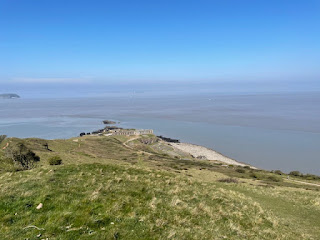- In 1873, Lionel de Rothschild (grandson of Mayer Amschel Rothschild, the man who started the famous European banking dynasty) bought a farm at Ascott for his son, Leopold. The architects took the original farmhouse and turned it into a hunting lodge and then a fashionable country house that Leopold could use for entertaining guests. He also had a successful stud nearby.
- Leopold's sister Evelina was the wife of Ferdinand de Rothschild, the creator of Waddesdon Manor
- In 1947 the house and some of its contents were given to the National Trust.
- Sir Evelyn de Rothschild and his family still use the house on occasions and it is only open to the public at certain times, so be sure to book before you visit.
A blog dedicated to finding the best National Trust scones by visiting every single property with a tea room.
Friday, 29 April 2022
Ascott
Friday, 15 April 2022
Brean Down
The most important piece of advice I can give anyone is simply this: never trust a bus timetable. There have been a few occasions during this National Trust Scone Odyssey when I have required the services of a bus and I can honestly say, hand on heart and without exception, that I have always been completely stunned when the bus actually turned up. And to be fair, they've turned up more often than they haven't. But I'm still always really surprised when they do.
And I will add to this, because there is one particular day of the year when you must NEVER trust a bus timetable and that is Good Friday. At least on Christmas Day you can be certain that there won't be a bus. But Good Friday? Just don't go there.
Anyway, today I went there, despite knowing the above. I checked the timetable for the bus service that goes to Brean Down from Weston-super-Mare and it clearly showed a service for public holidays. But there was no bus. Luckily, I knew the Brean Down Way provided an 8-mile walk from Brean to Weston. I'd been deliberating whether to attempt it, so the bus shortage made my mind up, while a taxi took me out there.
The slight snag with doing an 8 mile walk after a visit to Brean Down is that Brean Down itself requires a bit of effort. A nice amble on the beach it is not. As I dragged myself up the steps to reach the top of the promontory, I found myself thinking "is this fun? I'm not sure this is fun", before I reached the summit and was treated to the amazing views that make a climb worthwhile.
Let me tell you a little bit about Brean Down:
- Brean Down is a promontory stretching 1.2 miles into the Bristol Channel
- People have used Brean Down for thousands of years - a possible long barrow mound suggests Neolithic occupation, while remains of an Iron Age hill fort and Roman temple have also been found
- In the 19th century, plans were drawn up to turn Brean Down into a harbour that could act as a transatlantic port. The project was beset with problems and it didn't materialise.
- Brean Fort was built at the far end of Brean Down between 1865-1872 as part of a chain of forts designed to protect against the French.
- The main building we see today (below) was the barracks for 50 men
- The fort was refortified in 1941 during World War II
The Brean Down Scone
Scone: 5 out of 5
Walking the Brean Down Way path to Weston-super-Mare: 5 out of 5









